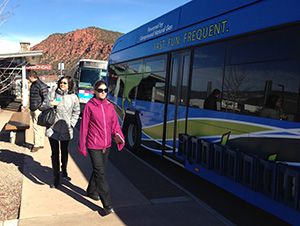Is there a place for Transit-oriented development (TOD) in small rural mountain towns of the West? The Roaring Fork Transportation Authority (RFTA) in Colorado believes so as it launches the nation’s first rural Bus Rapid Transit (BRT) system this fall.
Steer Davies Gleave is working with RFTA and its partner agencies to assess the potential to focus higher-intensity mixed-use development around their new VelociRFTA BRT stations, the thought being that promoting TOD creates a win-win situation for both the transit agency and the local towns. TOD could offer built-in ridership for the BRT system and orderly concentrated development for towns that desire managed growth.
Over the last few decades, the entire Roaring Fork Valley has experienced tremendous development pressure created by a burgeoning tourism industry, an influx of new businesses, and the lure of mountain living. Not surprisingly, State Highway 82 between Aspen and Glenwood Springs has become Colorado’s most congested rural highway. The introduction of a 38-mile BRT line between the two cities will connect the handful of towns within the valley and is expected to provide a more convenient, reliable, and faster way to travel. Bells and whistles for the $46 million BRT service include new branded low floor vehicles, use of HOV lanes, traffic signal priority, real-time traveler information, and branded stations.
Coordinating this major investment with well-designed transit-supportive land uses has the potential to mitigate development pressures in the rural areas of the valley and provide a more efficient provision of services. Growth management is not a new concept in the valley, nor is mixed use. Surrounded by mountains, the constrained geography of the valley makes for a variety of development types within close proximity to each other. Places like downtown Basalt and Carbondale are vibrant areas with a mix of uses and activity. Over the past several years, live-work developments have sprouted up in these rural towns, as have New Urbanist communities. TOD has the potential to build on this precedent for mixing uses. To do so successfully however, and to garner support by the local communities, TOD must be designed to complement, rather than compete with, the existing character of these unique places. And it should do so in a scale that is appropriate to the rural character of the region.
Since RFTA launched its BRT service in September 2013, it has been one step ahead in planning for a well-integrated transit-land-use system. Yet questions remain. Will tourists visiting the Aspen-Snowmass area - one of the world’s most upscale ski resorts - be drawn to the convenience of BRT? Quite possibly. Will the thousands of workforce commuters traveling through the valley use BRT? Most definitely. And will developers see BRT as a springboard for new development opportunities? RFTA believes and hopes so.
Ultimately, whether adjacent to an upscale ski village or an aging subdivision, each BRT station has the potential to provide convenient access for all modes and, in select cases, the added benefit of catalyzing compact, walkable, and vibrant development. The Roaring Fork Valley will not only host the first rural BRT system in the country, it will also become a model for how to incorporate the principles of TOD into a rural setting. Steer Davies Gleave will be working with RFTA and its member jurisdictions over the next few months to develop this unique approach to TOD planning, with the aim of producing templates and typologies that the towns up and down the Roaring Fork Valley can use to guide their future development in an orderly and beneficial way.
